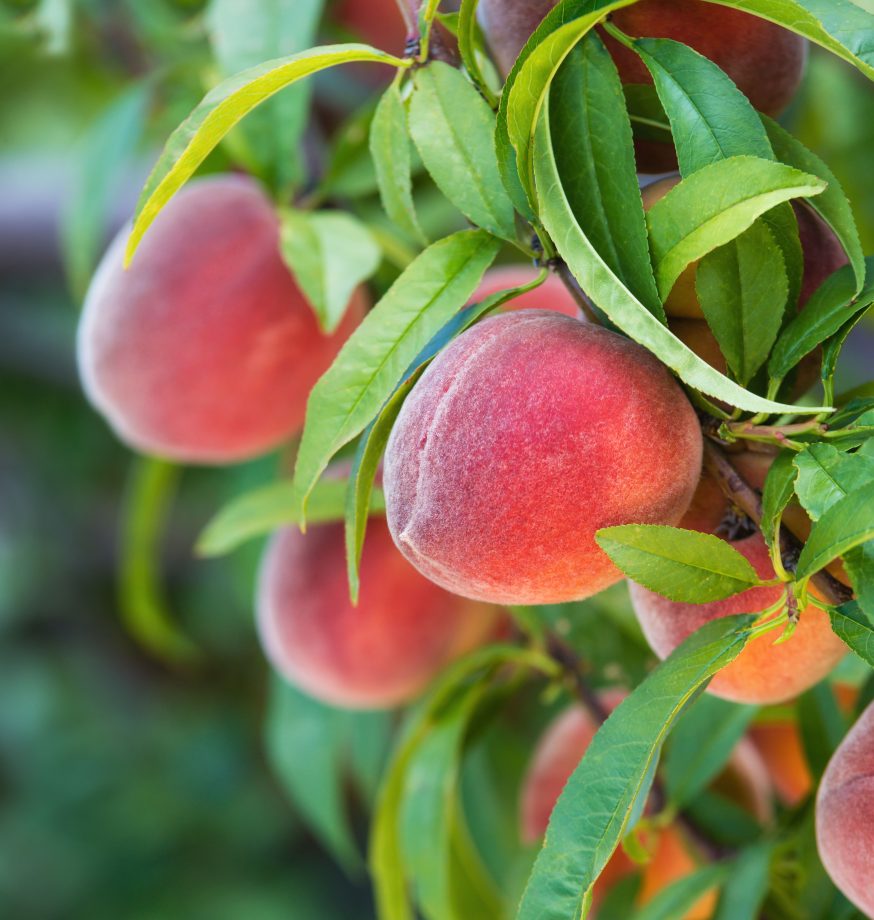Steven Desmond explains how you can produce these delicious, luxurious fruits on your own soil.
The peach is a luxurious fruit, an emblem of summer riches, which we seldom see in its true glory if we buy it from a shop. The alternative is to grow it ourselves. A well-grown glasshouse peach tree stretched out against a whitewashed wall is an arresting sight when the ripe fruits are evenly spaced along its branches. The scent is something never to be forgotten. Once you taste your own ripe peach, there is no going back.
Much of this glory can be emulated on a tree grown out of doors if a few essentials are attended to. The cultivation regime is much the same, but there are naturally some variations.
In case you’re wondering, everything that follows relates equally to the nectarine, which, as Mr Bunyard observed, is merely a ‘peach that has lost its duvet’…
1. Choose a type of peach
The first decision is which cultivar to choose. For a tree fan-trained against a wall, I suggest one of two tried and tested names. The first is Peregrine, bred long ago by the famous Rivers nursery, one of a series named after birds of prey. It has proved its worth over the years in many parts of the country and has the coveted Award of Garden Merit (AGM) from the RHS, a title whose worth is upheld by periodic reappraisal.
And what of the eating quality? Well, this is a white-fleshed peach, therefore suitable for your homemade Bellini. No less a judge than Edward Bunyard wrote in 1933 that ‘if one peach only is to be grown, this would certainly be my choice’. His judgment, in The Anatomy of Dessert, still carries weight.
You could also try a good old Duke of York, also with its AGM, of which Bunyard opined that ‘the skin is of a rich crimson hue, and the pale greenish-yellow flesh melting and refreshing’. Hmm.
2. Choose where to plant it
Choose your planting site with care. The ideal spot is a south-west facing brick wall of the kitchen-garden persuasion. Most soils will do, although shallow chalk will not. Remember that fruit trees exist to provide fruit, not leaves, so excessive fertility isn’t required.
Your tree will be trained as a fan and can readily be bought well on the way to that form. The branch structure makes a beautiful pattern against the wall when the flowers appear, strikingly bright pink like those of the almond.
3. Tackle the deadly enemy: Frost
At this point, alarm bells ring. Everyone knows that the almond’s pretty blossom appears sometime in late March or early April, when frost is in the air, and the same is true of the peach. This is why a south-west wall is favoured, on which the sun’s rays will not fall until the frost has thawed on the blooms.
One initially unnoticed side-effect of frost damage on a peach tree is that it permits the spores of a notorious fungal disease called peach leaf curl to enter the leaf tissues. This disfiguring disease, whose red weals are familiar to every outdoor peach grower, can best be managed by adapting the excellent Victorian practice of hanging a hessian curtain in front of the tree during frosty weather.

The modern variation on this theme involves constructing a simple frame of timber battens to hold a sheet of clear, heavy-duty plastic 1ft in front of the trained tree, complete with a ‘roof’ joined to the wall. The base of the sheet is raised 1ft above ground level by another batten. This contraption keeps frost off the plant tissues, prevents rain splashback spreading the spores and allows cold air to flow away at the base.
4. Thinning it out
When the fruits have set, there will be far too many, so a routine thinning is required. This is simple enough. When the fruits have reached the size of peas, pick off the surplus to leave one fruit every 6in or so.
You will see that the flowers are borne on last year’s shoots, so the pruning regime consists of bringing on the new shoot from the base of each lateral branch and cutting the others back to a single leaf each.
5. The final step
After the harvest in August, the fruited wood is cut back to that replacement shoot. By then, you will have revelled in juicy splendour for weeks, as the peach ripens its fruits successively over that period. Each year will be different, but a few will be memorable.
Just think of all those peaches warm from your own tree. Mr Bunyard suggests a glass of claret by way of accompaniment.
– – –
Steven Desmond is a freelance landscape consultant, specialising in the conservation of historic gardens

Delicious ways to cook peaches
Our kitchen garden cook makes pork with peaches, peach and parma ham foccacia, and caramelised peaches with vanilla ice cream

Our guide to planting heritage apples
Charles Quest-Ritson plants heritage apples.

The best fruit trees for your garden
Country Life’s guide to the best fruiting trees to plant in your garden.




